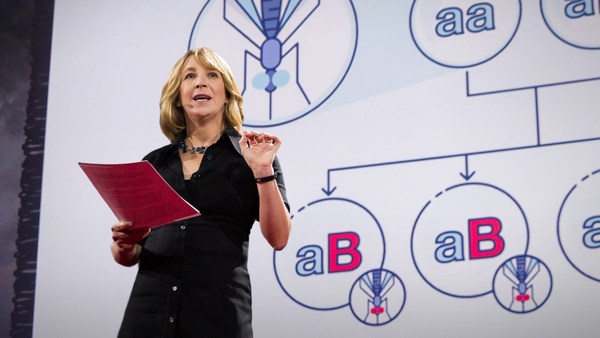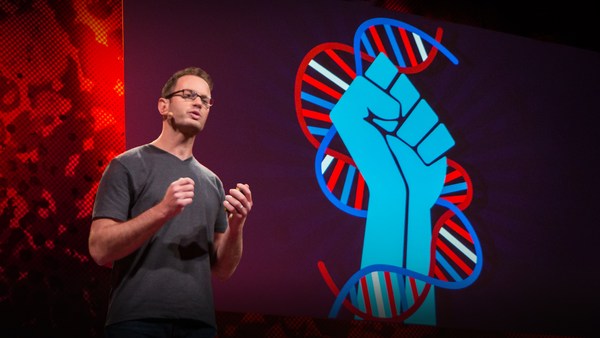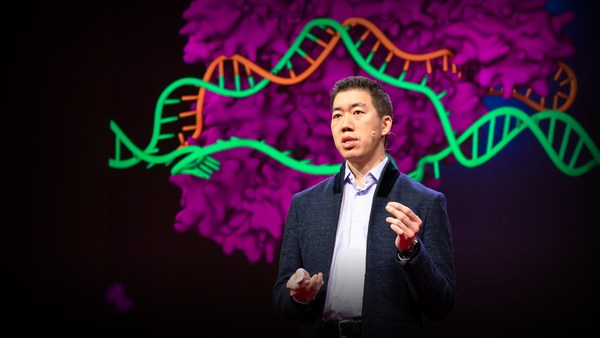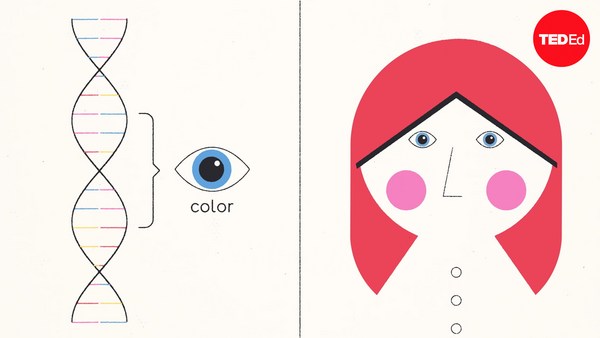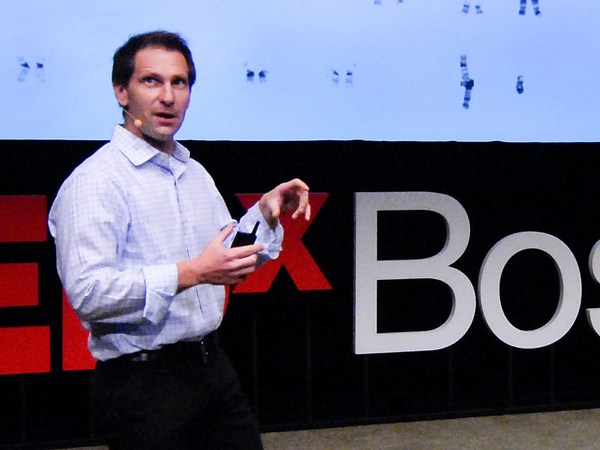So, has everybody heard of CRISPR? I would be shocked if you hadn't.
This is a technology -- it's for genome editing -- and it's so versatile and so controversial that it's sparking all sorts of really interesting conversations. Should we bring back the woolly mammoth? Should we edit a human embryo? And my personal favorite: How can we justify wiping out an entire species that we consider harmful to humans off the face of the Earth, using this technology?
This type of science is moving much faster than the regulatory mechanisms that govern it. And so, for the past six years, I've made it my personal mission to make sure that as many people as possible understand these types of technologies and their implications.
Now, CRISPR has been the subject of a huge media hype, and the words that are used most often are "easy" and "cheap." So what I want to do is drill down a little bit deeper and look into some of the myths and the realities around CRISPR.
If you're trying to CRISPR a genome, the first thing that you have to do is damage the DNA. The damage comes in the form of a double-strand break through the double helix. And then the cellular repair processes kick in, and then we convince those repair processes to make the edit that we want, and not a natural edit. That's how it works. It's a two-part system. You've got a Cas9 protein and something called a guide RNA. I like to think of it as a guided missile. So the Cas9 -- I love to anthropomorphize -- so the Cas9 is kind of this Pac-Man thing that wants to chew DNA, and the guide RNA is the leash that's keeping it out of the genome until it finds the exact spot where it matches. And the combination of those two is called CRISPR. It's a system that we stole from an ancient, ancient bacterial immune system.
The part that's amazing about it is that the guide RNA, only 20 letters of it, are what target the system. This is really easy to design, and it's really cheap to buy. So that's the part that is modular in the system; everything else stays the same. This makes it a remarkably easy and powerful system to use.
The guide RNA and the Cas9 protein complex together go bouncing along the genome, and when they find a spot where the guide RNA matches, then it inserts between the two strands of the double helix, it rips them apart, that triggers the Cas9 protein to cut, and all of a sudden, you've got a cell that's in total panic because now it's got a piece of DNA that's broken.
What does it do? It calls its first responders. There are two major repair pathways. The first just takes the DNA and shoves the two pieces back together. This isn't a very efficient system, because what happens is sometimes a base drops out or a base is added. It's an OK way to maybe, like, knock out a gene, but it's not the way that we really want to do genome editing.
The second repair pathway is a lot more interesting. In this repair pathway, it takes a homologous piece of DNA. And now mind you, in a diploid organism like people, we've got one copy of our genome from our mom and one from our dad, so if one gets damaged, it can use the other chromosome to repair it. So that's where this comes from. The repair is made, and now the genome is safe again.
The way that we can hijack this is we can feed it a false piece of DNA, a piece that has homology on both ends but is different in the middle. So now, you can put whatever you want in the center and the cell gets fooled. So you can change a letter, you can take letters out, but most importantly, you can stuff new DNA in, kind of like a Trojan horse.
CRISPR is going to be amazing, in terms of the number of different scientific advances that it's going to catalyze. The thing that's special about it is this modular targeting system. I mean, we've been shoving DNA into organisms for years, right? But because of the modular targeting system, we can actually put it exactly where we want it.
The thing is that there's a lot of talk about it being cheap and it being easy. And I run a community lab. I'm starting to get emails from people that say stuff like,
"Hey, can I come to your open night and, like, maybe use CRISPR and engineer my genome?"
(Laugher)
Like, seriously.
I'm, "No, you can't."
(Laughter)
"But I've heard it's cheap. I've heard it's easy."
We're going to explore that a little bit. So, how cheap is it? Yeah, it is cheap in comparison. It's going to take the cost of the average materials for an experiment from thousands of dollars to hundreds of dollars, and it cuts the time a lot, too. It can cut it from weeks to days. That's great. You still need a professional lab to do the work in; you're not going to do anything meaningful outside of a professional lab. I mean, don't listen to anyone who says you can do this sort of stuff on your kitchen table. It's really not easy to do this kind of work. Not to mention, there's a patent battle going on, so even if you do invent something, the Broad Institute and UC Berkeley are in this incredible patent battle. It's really fascinating to watch it happen, because they're accusing each other of fraudulent claims and then they've got people saying, "Oh, well, I signed my notebook here or there." This isn't going to be settled for years. And when it is, you can bet you're going to pay someone a really hefty licensing fee in order to use this stuff. So, is it really cheap? Well, it's cheap if you're doing basic research and you've got a lab.
How about easy? Let's look at that claim. The devil is always in the details. We don't really know that much about cells. They're still kind of black boxes. For example, we don't know why some guide RNAs work really well and some guide RNAs don't. We don't know why some cells want to do one repair pathway and some cells would rather do the other.
And besides that, there's the whole problem of getting the system into the cell in the first place. In a petri dish, that's not that hard, but if you're trying to do it on a whole organism, it gets really tricky. It's OK if you use something like blood or bone marrow -- those are the targets of a lot of research now.
There was a great story of some little girl who they saved from leukemia by taking the blood out, editing it, and putting it back with a precursor of CRISPR. And this is a line of research that people are going to do. But right now, if you want to get into the whole body, you're probably going to have to use a virus. So you take the virus, you put the CRISPR into it, you let the virus infect the cell. But now you've got this virus in there, and we don't know what the long-term effects of that are. Plus, CRISPR has some off-target effects, a very small percentage, but they're still there. What's going to happen over time with that?
These are not trivial questions, and there are scientists that are trying to solve them, and they will eventually, hopefully, be solved. But it ain't plug-and-play, not by a long shot. So: Is it really easy? Well, if you spend a few years working it out in your particular system, yes, it is.
Now the other thing is, we don't really know that much about how to make a particular thing happen by changing particular spots in the genome. We're a long way away from figuring out how to give a pig wings, for example. Or even an extra leg -- I'd settle for an extra leg. That would be kind of cool, right? But what is happening is that CRISPR is being used by thousands and thousands of scientists to do really, really important work, like making better models of diseases in animals, for example, or for taking pathways that produce valuable chemicals and getting them into industrial production in fermentation vats, or even doing really basic research on what genes do.
This is the story of CRISPR we should be telling, and I don't like it that the flashier aspects of it are drowning all of this out. Lots of scientists did a lot of work to make CRISPR happen, and what's interesting to me is that these scientists are being supported by our society.
Think about it. We've got an infrastructure that allows a certain percentage of people to spend all their time doing research. That makes us all the inventors of CRISPR, and I would say that makes us all the shepherds of CRISPR. We all have a responsibility.
So I would urge you to really learn about these types of technologies, because, really, only in that way are we going to be able to guide the development of these technologies, the use of these technologies and make sure that, in the end, it's a positive outcome -- for both the planet and for us.
Thanks.
(Applause)

